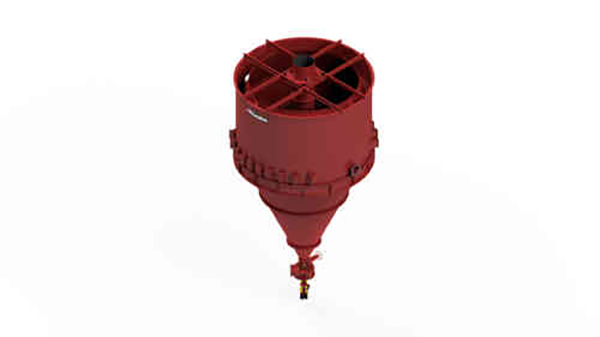Hydrosizers™

When extremely sharp classification is needed to separate
How Hydrosizers Work
To make its extremely sharp classification, Hydrosizers™ use the hindered settling principle. This phenomenon is the result of a fluidized (teetering) bed of particles or dense media created in the vertical-walled separation zone.
Feed material (typically Hydrocyclone underflow) enters the top of the unit via a central feed-well. Simultaneously, process water is injected through an array of pipes located near the bottom of the separation chamber. This water injection causes an upward rising current of water that flows over the peripheral weir and is collected in the overflow launder. As particles in the feed meet this rising current of water, finer and less dense fractions are lifted out and swept over the overflow weir. Coarser and denser particles pass downward through this current and are collected in the underflow cone to await discharge.
Particles that are near the size of separation, being neither massive enough to migrate to the underflow cone nor small enough to be lifted out, begin to accumulate in the separation chamber. This accumulation is described as a teetered or fluidized bed, similar in many ways to quick sand. Within this teetered bed, solids settle through the tank in an environment known as hindered settling. This phenomenon slows down the settling rates of particles and allows them to be more critically reviewed as either a member of the coarse or fine fraction. Maintenance of this bed is easily done through a simple set of controls.
The McLanahan Hydrosizer™ maintains separation automatically through a simple PID control loop. All the operator has to do is set the water injection rate. The Hydrosizer™ control monitors the classification environment and adjusts the underflow valve to maintain a consistent performance. There are no screen cloths to maintain, the unit automatically compensates for changes in feed rate, and the only moving part is the underflow valve.
A valve and a flow meter is supplied with every unit so teeter water can be adjusted easily, either manually or automatically. Specially designed teeter water nozzles open when pressurized and provide an evenly distributed spray of water into the Hydrosizer™. On loss of water flow at shut down, the nozzles close and, along with a non-return valve, serve to prevent sand from entering into the teeter water piping.
Typical of Hydrosizers™ of the past, underflow valves have been of a non-linear design such as pinch or butterfly design. While these have been functional, there are disadvantages associated with matching open area with required underflow capacity and, due to their non-linearity, greater difficulty tuning the control loop. McLanahan’s latest development is a bespoke valve, which features a linear open/close profile for more accurate performance. The dart style valve is fully rubber lined and features spring-to-close actuation in the event of loss of air (preventing the vessel from emptying).
Dilute Hydrosizer™ overflow containing the lighter /smaller fractions is typically dewatered using Hydrocyclones or Separators and further dewatered using Dewatering Screens. The denser underflow stream is typically directly fed to a Dewatering Screen.
Where the units are being used for organics removal, such as in soils washing or lignite removal, the overflow will contain larger organics with the finer sand (equivalent weight particulates). In this case, an interstage screen is used to separate the larger organics from the finer sands. The screen underflow is directed to the dewatering circuit while the organics are either disposed of with plant effluent, collected for use for site restoration or collected for high temperature destruction in the case of contaminated soils.